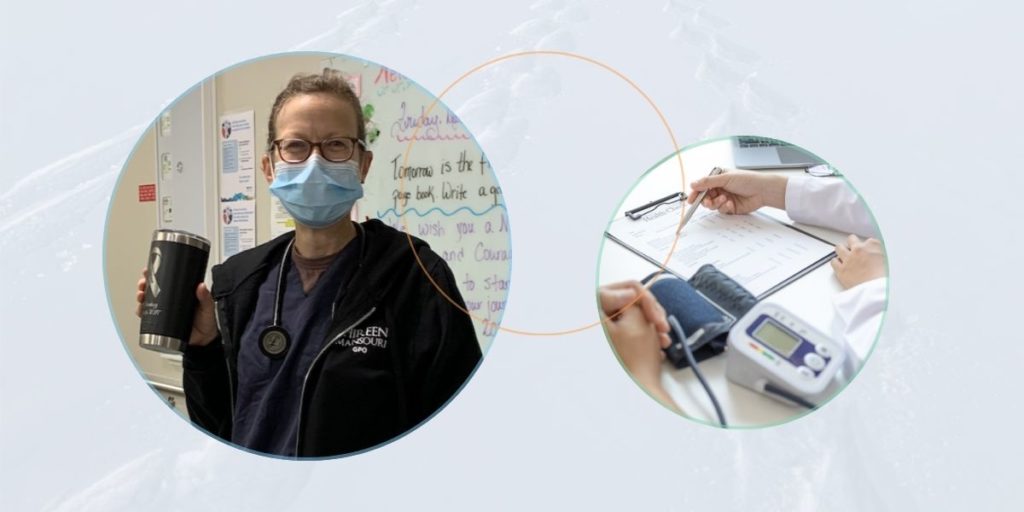Articles
What we’re contemplating, doing, and reading.
Is “Compassion Fatigue” Real? Get the Truth from a Practicing Physician
“Call it what it is — empathy fatigue!”
This is how I reacted to yet another article that used the phrase “compassion fatigue” in an imaginary conversation I was having with the author.
It reminds me of a moment I had years ago with our nurse practitioner after I described a patient as “a diabetic.” “A person with diabetes,” she said, gently correcting me. “Their diabetes does not define them,” she added.
I then adjusted my wording as I continued to describe my patient, and ask advice of this team member (who is also a certified diabetes educator).
I really appreciated her consistent quiet reminders of how important language is. Similarly, I have come to believe that using the term “compassion fatigue” can be harmful — and it goes beyond merely wanting to use the correct terminology.
As I wrote in an article last May, I was originally skeptical of efforts to debunk this common phrase. I’ve heard it referenced my entire career, and it provides an easy shorthand to describe how I’ve often felt in my clinical spaces.
There’s no question that in the health field there’s an increasing amount of suffering amongst health care providers. We’re under increasing pressures to provide exceptional and compassionate care — with fewer and fewer resources. We have a feeling of being chronically drained and exhausted, and we need a term that encompasses that. In response, we’ve seen more and more authors adopting “compassion fatigue” as a descriptor, which seems to resonate with many people. So how can using it be harmful?
The definition of compassion fatigue can vary from: “The physical and mental exhaustion and emotional withdrawal experienced by those who care for sick or traumatized people over an extended period of time (per Mirriam Webster)” to the “cost of caring1.”
The term “compassion fatigue,” however, gives the impression that compassion is a finite resource that must be rationed or it will eventually run out. This can result in a practitioner or individual shutting down or guarding against this possible drain — which often translates to shutting themselves off from patients and colleagues.
Compassion vs. Empathy
Despite the definitions, neuroscientific research has shown that what we are draining is in fact empathy, and that compassion is actually a “renewable resource.”
With the advent of fMRI machines, studies over the last 10 years have shown the distinct difference between empathy and compassion. Although empathy is an essential part of compassion, it’s not the whole story, but rather the beginning.
Empathy is the ability to be aware of someone’s suffering and to connect to it. Without caring about someone’s pain, there can be no compassion.
Compassion, however, is the next step, and it includes the wish to relieve that suffering. It requires the ability to empathize with the person — and move through that feeling of empathy — in order to know what the best action is to relieve that suffering.
The neuroscientific studies have shown that different parts of the brain are “lit up,” depending on which state we are in. When feeling empathy, the areas of our brain that are activated are the same areas that feel pain, whereas when feeling compassion, it’s the caregiving and reward areas that are activated.2
It then makes sense that if one remains in state of empathy — and thus a state of pain — we will want to retreat from that feeling. As a result, we can end up shutting down and protecting ourselves. This describes the state of “empathic distress.” It’s a state where we turn away from suffering and become disconnected from the one who is suffering.
This is in contrast with being in what’s often termed a “pro-social state,” where we’re feeling care and connection. In this state, we feel open and in relationship with others. Additionally, it’s accompanied physiologically by secretion of oxytocin, dopamine, and progesterone.
It’s the activation of the “tend and befriend” part of our brain, along with these “feel good” hormones, that produce what is called the “warm glow of compassion.” Being able to notice the positive effects of our compassion and this warm glow — sometimes called “compassion satisfaction” — is key to creating a positive feedback loop that then promotes more compassion.
Creating an Abundance Mindset
Our current medical culture tends to be deficit-minded — emphasizing what is wrong instead of what is going well. In this case, using a term such as compassion fatigue. What if, instead, we created a mindset of abundance and focused on what’s going well?
Turning our attention to compassion satisfaction could parallel the work that the Institute for Health Care Improvement is doing to change the narrative from “What’s the matter with you?” to “What matters to you?”
A recent study questioned whether the term “compassion fatigue” may in fact be reinforcing negative views of compassion, sharing, “Narratives surrounding compassion may be influencing perceptions and could be contributing to a self-fulfilling prophecy.3”
Are we contributing to a negative spiral of burnout with our current terminology and focus on the negative emotion?
Obstacles to Compassion
Another perspective on this subject is seen in the work that Shane Sinclair has done. He has proposed that the term “compassion distress4” is similar to “moral distress” — which he explains is “the inability to relieve suffering as a result of compassion being obstructed, mistargeted, or not having its intended effect.”
The term “compassion distress” acknowledges our individual efforts at compassion, while also recognizing that there are many systemic issues that can get in the way. Kathleen Ledoux, a fellow Compassion Cultivation Training (CCT™) teacher, shares in her article “Understanding Compassion Fatigue” that it is not the act of caring which creates nurse suffering, but when care is obstructed.5
I’m sure we can all think of times when we have experienced this. For me, personally, visitor restrictions for patients during the pandemic were a frequent example of this. At the time, I was working in an oncology unit with people facing difficult and complex care who were being told that they couldn’t have a loved one with them. This provided a daily frustration for me. And being able to name this feeling was at least a first step towards understanding it and determining what next steps I could take.
The term “compassion fatigue” could also reinforce the idea that the problem is with the individual — ignoring the systemic issues that can block compassion. This mirrors the argument made by Wendy Dean and Simon Talbot (“Healing Moral Injury”) that the term “burnout” focuses on individual weakness, whereas the term “moral injury” more accurately reflects the systemic issues that are resulting in clinician distress.6
Similarly, compassion fatigue could be interpreted as an individual failure to have enough compassion, rather than looking at the systems that put up the barriers.
As we saw in the research showing that compassion results in the activation of the caregiving and reward centers of our brain, it makes sense that compassion can mitigate the pain we feel in empathy. We’re now also learning that compassion can be trained7, and like a muscle, can be strengthened. This then debunks the idea that compassion is a finite resource — moving us away from an “economic model” of compassion and towards viewing it as a renewable resource.
The Strength of Compassion
In addition to being cultivated through training, increased levels of compassion have been shown to be protective against burnout in health care professionals. Additionally, increased levels of self-compassion have been shown to correlate with lower scores on the three elements of burnout (exhaustion, detachment, and feelings of ineffectiveness) 9. This has enormous implications for the power of compassion to be used to protect us from exhaustion.
This brings us to attention and awareness. It’s only by being able to see where our system is blocking compassion that we can begin to advocate for change. We can also focus on what’s already going well. By shining awareness on moments of “compassion satisfaction” — and savoring them, without glossing over or dismissing them — we can derive the benefits of our actions. These are just two elements of Compassion Cultivation Training© that allow us to strengthen our compassion muscle.
What would happen if we started to talk about the strength of compassion? If we started to think of compassion as a skill that can enhance our ability to stay with the suffering that we see every day, and can protect us from the deleterious effects of burnout?
Changing the language will not solve all of the problems in health care, or anywhere. But it can give us a new lens with which to view our current challenges … and move towards potential solutions.
Health professionals, you’re invited to join Shireen Mansouri, M.D. for her online Compassion Cultivation Training (CCT™) Workshop for the Health Sector — taking place June 22 and 23, 2024.
Click here to find other upcoming Compassion Institute programs.
Not a health professional, but still want to experience the transformative power of compassion?
1 Figley, C. R. (2002). Treating Compassion Fatigue (Figley, C. R., ed.), Routledge, New York, NY.
2 Klimecki OM, Leiberg S, Lamm C, Singer T. Functional neural plasticity and associated changes in positive affect after compassion training. Cereb Cortex. 2013 Jul;23(7):1552-61. Doi: 10.1093/cercor/bhs142. Epub 2012 Jun 1. PMID: 22661409.
3 Gainsburg I, Lee Cunningham J., Compassion Fatigue as a Self-Fulfilling Prophecy: Believing Compassion Is Limited Increases Fatigue and Decreases Compassion. Psychol Sci. 2023 Sep 22:9567976231194537. doi: 10.1177/09567976231194537. Epub ahead of print. PMID: 37737148.
4 Compassion fatigue: A meta-narrative review of the healthcare literature, Sinclair et al International Journal of Nursing Studies Volume 69, April 2017, Pages 9-24
5 LEDOUX K. (2015) Understanding compassion fatigue. Journal of Advanced
Nursing 00(0), 000–000. doi: 10.1111/jan.12686
6 Dean and Talbot https://www.statnews.com/2018/07/26/physicians-not-burning-out-they-
are-suffering-moral-injury/
7 Jazaieri, H., Jinpa, G.T., McGonigal, K. et al. Enhancing Compassion: A Randomized
Controlled Trial of a Compassion Cultivation Training Program. J Happiness Stud 14, 1113–1126 (2013). https://doi.org/10.1007/s10902-012-9373-z
8 Scarlet, J., Altmeyer, N., Knier, S. and Harpin, R.E. (2017), The effects of Compassion
Cultivation Training (CCT) on health-care workers. Clin Psychol, 21: 116-
124. https://doi.org/10.1111/cp.12130
9 Hashem et al Self Compassion explains less burnout amongst health care professionals Mindfulness (2020) 11:2542–2551






